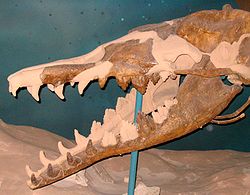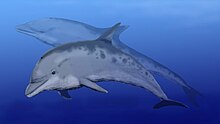Anexo:Cetáceos fósiles
| Cetáceos fósiles | ||
|---|---|---|
 | ||
| Taxonomía | ||
| Reino: | Animalia | |
| Filo: | Chordata | |
| Clase: | Mammalia | |
| Orden: | Artiodactyla | |
| Infraorden: | Cetacea | |
Esta lista solo indica a las especies de cetáceos extintas conocidas por sus fósiles, por lo tanto, no incluye al baiji (Lipotes vexillifer), a pesar de estar considerado extinto desde el año 2006.
Parvorden Archaeoceti[editar]
Familia Ambulocetidae[editar]
(Eoceno)

Familia Basilosauridae[editar]
(Eoceno tardío)

Familia Kekenodontidae[editar]
(Oligoceno)
Familia Pakicetidae[editar]
(Eoceno inicial a medio)

Familia Protocetidae[editar]
(Eoceno)

Familia Remingtonocetidae[editar]
(Eoceno)
Parvorden Mysticeti[editar]
Familia Aetiocetidae[editar]
(Oligoceno)

Familia Llanocetidae[editar]
(Eoceno tardío)
Familia Mammalodontidae[editar]
(sinónimo Janjucetidae)

(Oligoceno tardío)
Clado Chaeomysticeti[editar]
Superfamilia Eomysticetoidea[editar]
Familia Cetotheriopsidae[editar]
(Oligoceno a Mioceno)
Familia Eomysticetidae[editar]
(Oligoceno)
Superfamilia Balaenoidea[editar]
Familia Balaenidae[editar]
(Oligoceno a la actualidad)
- Balaena
- Balaenella
- Balaenotus
- Balaenula
- Eubalaena (extant)
- Idiocetus
- Morenocetus
- Peripolocetus
- Protobalaena
Familia Neobalaenidae[editar]
(Mioceno a la actualidad)
Clado Thalassotherii[editar]
Familia Cetotheriidae[editar]
(Mioceno - Actualidad)
Classification follows Steeman, 2007.[7]

- Brandtocetus
- Cephalotropis
- Cetotherium
- Eucetotherium
- Herentalia[8]
- Herpetocetus
- Hibacetus[9]
- Joumocetus[10]
- Kurdalagonus
- Metopocetus
- Nannocetus

Parietobalaena palmeri skull - Otradnocetus
- Piscobalaena[11]
- Titanocetus[12]
- Vampalus
- Zygiocetus[13]
Superfamilia Balaenopteroidea[editar]

Familia Aglaocetidae[editar]
(Mioceno a Plioceno)
Familia Balaenopteridae[editar]
(Oligoceno a la actualidad)
- Archaebalaenoptera
- Balaenoptera (extant)
- "Balaenoptera" cortesii
- "Balaenoptera" portisi
- "Balaenoptera" ryani
- Burtinopsis
- Cetotheriophanes
- Parabalaenoptera
- Plesiobalaenoptera
- Plesiocetus
- Praemegaptera
- Protororqualus
Familia Diorocetidae[editar]
(Mioceno a Plioceno)
Familia Eschrichtiidae[editar]
(Mioceno a la actualidad)
Familia Pelocetidae[editar]
(Mioceno)
Familia Tranatocetidae[editar]
Familia incertae sedis[editar]
- Horopeta
- Imerocetus (Mioceno tardío; Chaeomysticeti)
- Mioceta (nomen dubium)
- Piscocetus (Pliocene; Chaeomysticeti)
- Siphonocetus (nomen dubium)
- Tretulias (nomen dubium)
- Ulias (nomen dubium)
Parvorden Odontoceti[editar]
Formas basales[editar]
Familia Agorophiidae[editar]
(Oligoceno tardío)
Familia Ashleycetidae[editar]
(Oligoceno temprano)
Familia Mirocetidae[editar]
(Oligoceno temprano)
Familia Patriocetidae[editar]
(Oligoceno a Mioceno temprano)
Familia Simocetidae[editar]
(Oligoceno tardío)
Family Xenorophidae[editar]
(Oligocene)
Family Inticetidae[editar]
Superfamilia Squalodontoidea[editar]
Family Dalpiazinidae[editar]
(Oligoceno tardío al Mioceno)
Familia Prosqualodontidae[editar]
(Oligoceno a Mioceno)
Familia Squalodontidae[editar]
(Oligoceno a Plioceno)
- Austrosqualodon
- Eosqualodon
- Macrophoca
- Pachyodon
- Phoberodon
- Squalodon (syn. Kelloggia, Rhizoprion, Crenidelphinus, Arionius, Phocodon)
- Smilocamptus
- Tangaroasaurus
Familia Waipatiidae[editar]
(Oligoceno)
Superfamilia Physeteroidea[editar]
Familia Kogiidae[editar]
(Mioceno a la actualidad)
- Aprixokogia
- Kogia (extant)
- Nanokogia
- Praekogia
- Scaphokogia
- Thalassocetus
Familia Physeteridae[editar]
- Aulophyseter
- Diaphorocetus
- Ferecetotherium
- Idiophyseter
- Idiorophus
- Orycterocetus
- Physeterula
- Placoziphius
- Preaulophyseter
Familia incertae sedis[editar]
- Acrophyseter
- Albicetus
- Brygmophyseter
- Eudelphis
- Helvicetus (nomen dubium)
- Hoplocetus (nomen dubium)
- Kogiopsis
- Livyatan[18]
- Miokogia (nomen dubium)
- Paleophoca (nomen dubium)
- Placoziphius
- Prophyseter (nomen dubium)
- Scaldicetus (nomen dubium)
- Zygophyseter
Superfamilia "Eurhinodelphinoidea"[editar]
Familia Argyrocetidae[editar]
(Oligoceno tardío a Mioceno temprano)
Familia Eoplatanistidae[editar]
(Mioceno)
Familia Eurhinodelphinidae[editar]
(Mioceno medio a Plioceno)

- Ceterhinops
- Eurhinodelphis
- Iniopsis
- Mycteriacetus
- Phocaenopsis
- Schizodelphis
- Vanbreenia
- Xiphiacetus
- Ziphiodelphis
Superfamilia Platanistoidea[editar]
Familia Allodelphinidae[editar]
(Mioceno temprano a medio)
Familia Dalpiazinidae[editar]
(Oligoceno tardío a Mioceno)
Familia Platanistidae[editar]
(Mioceno a la actualidad)
Familia Squalodelphinidae[editar]
(Mioceno temprano a tardío)
Superfamilia Ziphioidea[editar]
Familia Squaloziphiidae[editar]
(Mioceno temprano)
Familia Ziphiidae[editar]
(Mioceno a la actualidad)
Classification after Bianucci et al. 2013[21]
- Formas basales
- Subfamilia Berardiinae
- Subfamilia Hyperoodontinae
- Africanacetus
- Ihlengesi
- Mesoplodon (extant)
- Subfamilia Ziphiinae
- Subfamilia incertae sedis
Clado Delphinida[editar]
Superfamilia Delphinoidea[editar]
Familia Albireonidae[editar]
(Mioceno a Plioceno)
Familia Delphinidae[editar]

(Oligoceno a la actualidad)
- Arimidelphis
- Astadelphis
- Australodelphis
- Delphinus (extant)
- Eodelphinus
- Etruridelphis
- Hemisyntrachelus
- Lagenorhynchus (extant)
- Orcinus (extant)
- Platalearostrum[23]
- Protoglobicephala
- Pseudorca (extant)
- Septidelphis[24]
- Sinanodelphis
- Stenella (extant)
- Tursiops (extant)
Familia Kentriodontidae[editar]
(Oligoceno tardío - Mioceno medio)

- Subfamilia Kentriodontinae
- Subfamilia Lophocetinae
- ?Subfamilia Pithanodelphininae
Familia Monodontidae[editar]
(Mioceno a Plioceno)
Familia Odobenocetopsidae[editar]
(Pliocene)

Familia Phocoenidae[editar]
(Mioceno a la actualidad)
- Archaeophocaena
- Australithax
- Brabocetus
- Haborophocoena
- Lomacetus
- Miophocaena
- Numataphocoena
- Piscolithax
- Pterophocaena
- Salumiphocaena
- Semirostrum[25]
- Septemtriocetus
Familia incertae sedis[editar]
- Anacharsis
- Delphinavus
- Graamocetus
- Miodelphis
- Oedolithax
- Oligodelphis
- Palaeophocaena
- Platylithax
- Prionodelphis
- Protodelphinus
Superfamilia Inioidea[editar]
Familia Iniidae[editar]
Familia Pontoporiidae[editar]
(Mioceno medio a la actualidad)
Superfamilia Lipotoidea[editar]
Familia Lipotidae[editar]
(Mioceno a la actualidad)
Familia incertae sedis[editar]
- Agriocetus
- Atropatenocetus (Oligoceno)
- Austrosqualodon (Oligoceno)
- Hesperocetus
- Imerodelphis (Mioceno)
- Kharthlidelphis
- Lonchodelphis
- Microsqualodon
- Microzeuglodon
- Neosqualodon
- Papahu (Mioceno)[26]
- Pelodelphis
- Rhabdosteus (nomen dubium)
- Saurocetus (Oligoceno)
Véase también[editar]
Páginas externas[editar]
Referencias[editar]
- ↑ http://deepblue.lib.umich.edu/bitstream/2027.42/57499/1/Vol%2031%20No%2013%20final%2012-19-07.pdf
- ↑ Gingerich, P.D. et al. 2001. Origin of Whales from Early Artiodactyls: Hands and Feet of Eoceno Protocetidae from Pakistan. (19 September 2001). Science doi 10.1126/science.1063902.
- ↑ a b Sunil Bajpai and J.G.M. Thewissen (2014). "Protocetid cetaceans (Mammalia) from the Eoceno of India". Palaeontologia Electronica 17 (3): Article number 17.3.34A.
- ↑ Philip D. Gingerich and Henri Cappetta (2014). «A New Archaeocete and Other Marine Mammals (Cetacea and Sirenia) from Lower Middle Eoceno Phosphate Deposits of Togo». Journal of Paleontology 88 (1): 109-129. doi:10.1666/13-040.
- ↑ Ryan M. Bebej, Iyad S. Zalmout, Ahmed A. Abed El-Aziz, Mohammed Sameh M. Antar and Philip D. Gingerich (2016). "First remingtonocetid archaeocete (Mammalia, Cetacea) from the middle Eoceno of Egypt with implications for biogeography and locomotion in early cetacean evolution". Journal of Paleontology. in press. doi:10.1017/jpa.2015.57.
- ↑ Felix G. Marx, Cheng-Hsiu Tsai and R. Ewan Fordyce (2015). "A new Oligoceno temprano toothed ‘baleen’ whale (Mysticeti: Aetiocetidae) from western North America: one of the oldest and the smallest". Royal Society Open Science 2 (12): 150476. doi:10.1098/rsos.150476.
- ↑ M. E. Steeman (2007). «Cladistic analysis and a revised classification of fossil and Actualidad mysticetes». Zoological Journal of the Linnean Society 150 (4): 875-894. doi:10.1111/j.1096-3642.2007.00313.x.
- ↑ M. Bisconti. 2014. Anatomy of a new cetotheriid genus and species from the Mioceno of Herentals, Belgium, and the phylogenetic and palaeobiogeographical relationships of Cetotheriidae s.s. (Mammalia, Cetacea, Mysticeti). Journal of Systematic Palaeontology
- ↑ Otsuka, H.; Ota, Y. (2008). «Cetotheres from the early Middle Mioceno Bihoku Group in Shobara District, Hiroshima Prefecture, West Japan». Miscellaneous Reports of the Hiwa Museum for Natural History 49 (2): 1-66.
- ↑ Kimura, T.; Hasegawa, Y. (2010). «A new baleen whale (Mysticeti: Cetotheriidae) from the earliest Mioceno tardío of Japan and a reconsideration of the phylogeny of cetotheres.». Journal of Vertebrate Paleontology 30 (2): 577-591. doi:10.1080/02724631003621912.
- ↑ Bouetel, V.; Muizon, C. de (2006). pdf «The anatomy and relationships of Piscobalaena nana (Cetacea, Mysticeti), a Cetotheriidae s.s. from the early Pliocene of Peru.». Geodiversitas 28 (2): 319-395.
- ↑ Bisconti, M. (2006). «Titanocetus, a new baleen whale from the middle Mioceno of northern Italy (Mammalia, Cetacea, Mysticeti).». Journal of Vertebrate Paleontology 26 (2): 344-354. JSTOR 4524574. doi:10.1671/0272-4634(2006)26[344:tanbwf]2.0.co;2.
- ↑ K. K. Tarasenko (2014). "Novye rody usatykh kitov (Cetacea, Mammalia) iz miotsena Severnogo Kavkaza i Predkavkaz'ya. 3. Zygiocetus gen. nov. (srednii sarmat, Adygeya)". Paleontological Journal 48 (5).
- ↑ Robert W. Boessenecker (2013). «A new marine vertebrate assemblage from the Late Neogene Purisima Formation in Central California, part II: Pinnipeds and Cetaceans». Geodiversitas 35 (4): 815-940. doi:10.5252/g2013n4a5.
- ↑ Kellogg, R. (1934). «A new cetothere from the Modelo Formation at Los Angeles, California.». Carnegie Institution of Washington 447: 83-104.
- ↑ Fitzgerald, E.M.G. 2004. A review of the Tertiary fossil Cetacea (Mammalia) localities in Australia. Memoirs of Museum Victoria 61(2): 183-208.
- ↑ Yoshihiro Tanaka and R. Ewan Fordyce (2014). "Fossil Dolphin Otekaikea marplesi (Latest Oligoceno, New Zealand) Expands the Morphological and Taxonomic Diversity of Oligoceno Cetaceans". PLoS ONE 9 (9): e107972. doi:10.1371/journal.pone.0107972.
- ↑ Lambert, O., G. Bianucci, K. Post, C. de Muizon, R. Salas-Gismondi, M. Urbina & J. Reumer. (2010). The giant bite of a new raptorial sperm whale from the Mioceno epoch of Peru. Nature 466: 105–108. doi 10.1038/nature09067
- ↑ a b Kimura, T. and Barnes, L.G., 2016. New Mioceno fossil Allodelphinidae(Cetacea, Odontoceti, Platanistoidea) from the North Pacific Ocean. Bulletin of the Gunma Museum of Natural History 20:1-58.
- ↑ Olivier Lambert, Giovanni Bianucci, Mario Urbina, 2014. Huaridelphis raimondii, a new early Mioceno Squalodelphinidae (Cetacea, Odontoceti) from the Chilcatay Formation, Peru. Journal of Vertebrate Paleontology 34 (5):987-1004.
- ↑ O. Lambert, C. Muizon, and G. Bianucci. 2013. The most basal beaked whale Ninoziphius platyrostris Muizon, 1983: clues on the evolutionary history of the Familia Ziphiidae (Cetacea: Odontoceti). Zoological Journal of the Linnean Society 167:569-598
- ↑ Lambert, O., and S. Louwye. 2016. A new early Pliocene species of Mesoplodon: a calibration mark for the radiation of this species-rich beaked whale genus. Journal of Vertebrate Paleontology. DOI: 10.1080/02724634.2015.1055754.
- ↑ Klaas Post & Erwin J.O. Kompanje (2010). "A new dolphin (Cetacea, Delphinidae) from the Plio-Pleistocene of the North Sea". Deinsea 14: 1–13. ISSN 0923-9308.
- ↑ Giovanni Bianucci (2013). «Septidelphis morii, n. gen. et sp., from the Pliocene of Italy: new evidence of the explosive radiation of true dolphins (Odontoceti, Delphinidae)». Journal of Vertebrate Paleontology 33 (3): 722-740. doi:10.1080/02724634.2013.744757.
- ↑ Rachel A. Racicot, Thomas A. Deméré, Brian L. Beatty, Robert W. Boessenecker. Unique Feeding Morphology in a New Prognathous Extinct Porpoise from the Pliocene of California. Current Biology, 13 March 2014 DOI: 10.1016/j.cub.2014.02.031
- ↑ Gabriel Aguirre-Fernández and R. Ewan Fordyce (2014). «Papahu taitapu, gen. et sp. nov., an early Mioceno stem odontocete (Cetacea) from New Zealand». Journal of Vertebrate Paleontology 34 (1): 195-210. doi:10.1080/02724634.2013.799069.



